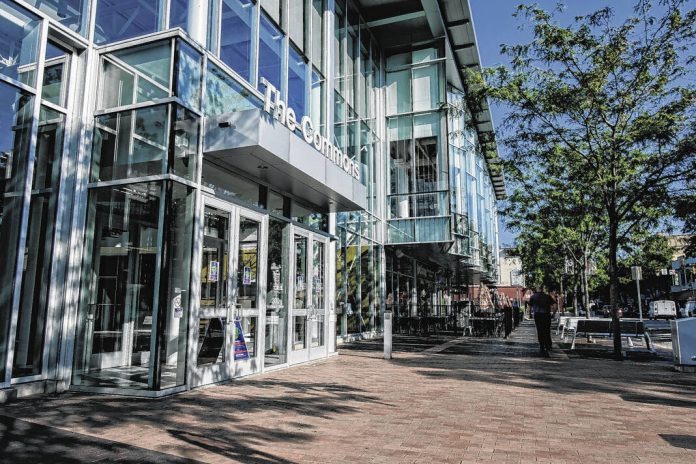
Mike Wolanin | The Republic An exterior view of The Commons in downtown Columbus, Ind., Wednesday, Sept. 8, 2021.
Bartholomew County’s population grew at a faster pace last year than the state and much of the rest of the country, nearly reversing a decline in population during the first year of the pandemic, as the economy continues to rebound from the public health emergency.
Bartholomew County saw a population increase of 810 between 2021 and 2022, raising the county’s estimated population to 83,540 as of July 1, 2022, just shy of the 2019 population estimate of 83,779, according to new estimates released by the U.S. Census Bureau.
The estimated growth in population in Bartholomew County represented a 0.98% increase from July 1, 2021. By comparison, the U.S. population grew by 0.38% and Indiana’s population increased 0.29% over the same period, while small towns in the Midwest saw their populations decline by 0.2%.
The city of Columbus also saw its population increase to 51,268, up from 50,792 the year before. Columbus Township saw the largest increase among all townships in the county, followed by German Township and Harrison Township.
Local officials described the increase in population as “heartening,” as a growing population generally leads to more economic activity.
“One of the things that I’ve learned down through the years is that growth is a whole lot easier to manage than decay,” said Columbus Mayor Jim Lienhoop. “We’re pleased to be able to have a situation where we have growth.”
Steve Mohler, an assistant professor of management at IUPUC, said the increase in population is a “positive” for the local economy, businesses and the community as a whole.
“I see it all as a positive for our economy, positive for businesses in particularly,” Mohler said. “They’re really struggling for people. With this growth going on in Bartholomew County, that’s good news for businesses. They’ll have more people that they can choose from when they want to hire.”
“It’s very positive for our community overall,” Mohler added. “Better tax dollars to support the schools and the local government.”
What’s driving the increase?
Changes in population are driven by migration, either domestically as people change cities or states or internationally as people move to the United States from other countries. It also depends on birth and death rates.
While the new Census Bureau estimates do not show the reasons why Bartholomew County’s population increased, similar county-level data released in March suggest that the local growth in population was mostly due to international migration.
An estimated 658 people moved to Bartholomew County from a foreign country between July 1, 2021, and July 1, 2022 — which would account for roughly 81% of the county’s population growth last year — according to the Census Bureau estimates released in March.
At the same time, the Census Bureau estimates show that the county had slightly negative domestic migration, meaning that the number of people who lived elsewhere in the U.S. and decided to move to Bartholomew County did not offset the number of people who left.
Additionally, there were 181 more births than deaths in Bartholomew County.
“(During the pandemic), people retired early and then moved, or if they didn’t have to work from the office anymore, they moved. There was a large group that moved to Florida and Texas,” Mohler said. “…I don’t think all of those (people) came home. We can’t look and say, ‘Oh, all of those came back.’ Some of them retired and went to Florida or Texas.”
“I think we’re seeing an influx of new people,” Mohler added.
Heading south
The new estimates from the U.S. Census Bureau show that the flight from urban areas during the first year of the pandemic either reversed or slowed in its second year, as metropolitan areas in Texas and Florida continued to experience a population boom, The Associated Press reported.
During the first full year of the pandemic in 2021, more than half of the 20 largest U.S. metro areas lost residents — including the Columbus metro area — and all U.S. metro areas grew by just 0.1%, as fear of the virus sent residents fleeing the most densely-populated urban areas and the popularity of remote work allowed people to live far from their workplaces.
By comparison, only eight of the 20 largest metro areas decreased in 2022, and the growth rate for all U.S. metros was 0.4%, according to wire reports. Among the largest U.S. metros that had gains in 2022 after experiencing losses in 2021 were Washington, Miami-Fort Lauderdale, Seattle, Minneapolis and San Diego, according to new population estimates released last month by the Census Bureau.
Nine of the nation’s 15 fastest-growing cities with populations of at least 50,000 were in Texas or Florida, with four of the five fastest-growing cities in the Lone Star State.
Georgetown, Texas, a suburb of Austin, was the fastest-growing city in the country in 2022, with an annual population increase of 14.4%. With an increase of 170,396 residents, the Dallas-Fort Worth metro area added the largest number of people last year.
The fastest growing city in Indiana with a population of at least 50,000 was Westfield, which saw a 7.7% increase from 2021 to 2022 and was the sixth fastest growing city in the nation over that period in terms of percentage increase. Westfield was the only city in the Midwest among the 15 fastest-growing cities in the nation.
Marion County, which includes Indianapolis, saw a 0.22% decline in population from 2021 to 2022, and Monroe County, which includes Bloomington, saw a 0.28% decline over the same period.
Jackson County’s population remained largely unchanged from 2021 to 2022 but has declined 0.35% since 2020, the new estimates show. Jennings County’s population ticked up slightly in 2022 but was still 0.16% lower than in 2020.
Economic recovery
Lienhoop said Columbus has “somewhat recovered” from the economic toll of the pandemic but that only time will tell what the new normal will be for Columbus and the surrounding area.
Data from the 2o2o U.S. Census and previous Census Bureau population estimates suggest that Bartholomew County’s population declined by about 1,570 during the first year of the pandemic. However, the county has seen steady increases in population since then, according to subsequent population estimates.
At the same time, many local businesses were hit hard by the pandemic, including downtown businesses that largely relied on foot traffic from downtown workers who started working from home or coming into office less frequently.
Cummins Inc., the largest employer in the community, has classified every position at the company as fully remote, fully in-person and hybrid, which is a mix of the two. Company officials previously said most positions are hybrid.
“I would say that we have recovered somewhat,” Lienhoop said. “I wouldn’t say that our recovery is complete. I think there is a little bit more room for improvement. We have got some more activity that we’re hoping for downtown. Hopefully, those employers who are headquartered downtown will see a greater increase in employees returning to work on a daily basis. But we’re not there yet. My anticipation is that we’ll have several months if not another year to go before we know what the new normal really is.”
“We still don’t know where office attendance will settle, whether it will be two days per week, four days per week or five,” Lienhoop said. “We understand that it won’t return to 2019 numbers, but we don’t know what it will level at. I think it will still take us a little bit to see how it plays out.”




